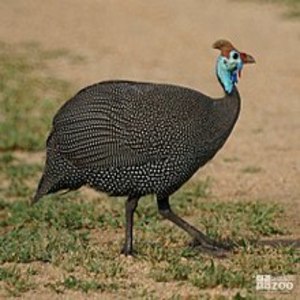 The helmeted guineafowl is the best known of the guineafowl bird family.They are related to turkeys, pheasants, partridges, grouse, quail, and chickens. They have plump roundish bodies that range in length from about 16-28 inches and weigh between 1.5 and 3.5 lbs. They are frequently domesticated and raised for their meat and eggs. The name is derived from a large backward curving dull-yellow or reddish bony “helmet” on top of its small head. The body is covered in blackish-gray feathers with tiny white spots that end in a type of pointed tail. Their heads and necks are featherless and blue in color. A wattle hangs on each side of the beak. While males and females look alike, males may have a larger helmet and wattles.
The helmeted guineafowl is the best known of the guineafowl bird family.They are related to turkeys, pheasants, partridges, grouse, quail, and chickens. They have plump roundish bodies that range in length from about 16-28 inches and weigh between 1.5 and 3.5 lbs. They are frequently domesticated and raised for their meat and eggs. The name is derived from a large backward curving dull-yellow or reddish bony “helmet” on top of its small head. The body is covered in blackish-gray feathers with tiny white spots that end in a type of pointed tail. Their heads and necks are featherless and blue in color. A wattle hangs on each side of the beak. While males and females look alike, males may have a larger helmet and wattles.
Location: Animals Formerly at Zoo
Share:
Range
Their natural range is in sub-Saharan Africa but they have been introduced to many parts of the world.
Habitat
Warm, dry and open semi-desert and savanna.
Conservation Status
Least Concern
Primary Threats
Gestation
25-30 days
Litter
12-15 eggs
Behavior
They are a gregarious and social bird and live in flocks outside of breeding season of about 25 birds. They become alarmed easily and if threatened, they call out with high shrieking voices. They may be kept as a “security system” against predators in a barnyard. Males make “kek-kek” or “chi-chi” calls while the female makes the 2-note cry imitated as “buck-wheat”. They are highly social birds who don’t do well if alone. Much of their day is spent scratching for food. They are generally sedentary but can cover long distances during their daily wanderings. Though they can fly, they seem to prefer to walk or run, and usually roost in trees at night. Since they eat large numbers of ticks, they are valuable as pest controllers around farms and help to control Lyme Disease.
Reproduction
Guineafowl are usually monogamous and tend to reproduce seasonally; peak season being summer. They lay 12-15 eggs in a nest scratched into the ground and which may be hidden by a clump of weeds or other cover. Their eggs are small and extremely thick shelled. The chicks are called “keets” and they are cared for by both parents. The newly hatched keets are highly susceptible to dampness, but after a few weeks they become some of the hardiest domestic land fowl.
Wild Diet
They are omnivores, eating seeds, berries, spiders, worms, other small invertebrates and a wide variety of insects including ants, termites, wasps, and ticks.
Zoo Diet

